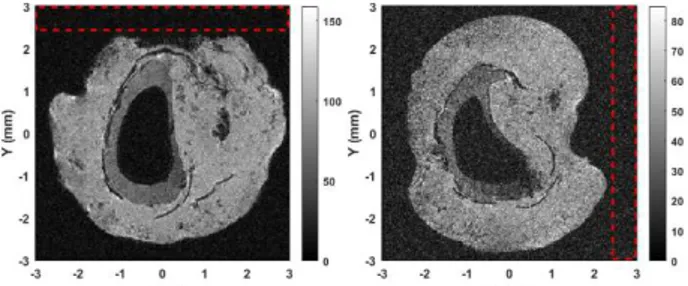HAL Id: hal-02516167
https://hal.archives-ouvertes.fr/hal-02516167
Submitted on 23 Mar 2020HAL is a multi-disciplinary open access archive for the deposit and dissemination of sci-entific research documents, whether they are pub-lished or not. The documents may come from teaching and research institutions in France or abroad, or from public or private research centers.
L’archive ouverte pluridisciplinaire HAL, est destinée au dépôt et à la diffusion de documents scientifiques de niveau recherche, publiés ou non, émanant des établissements d’enseignement et de recherche français ou étrangers, des laboratoires publics ou privés.
Ferroelectric Composite Ceramic Probe for MRM
Marine Moussu, Stanislav Glybovski, Elizaveta Nenasheva, Redha
Abdeddaim, Stefan Enoch, Luisa Ciobanu
To cite this version:
Marine Moussu, Stanislav Glybovski, Elizaveta Nenasheva, Redha Abdeddaim, Stefan Enoch, et al.. Ferroelectric Composite Ceramic Probe for MRM. International Conference on Magnetic Resonance Microscopy (ICMRM), Aug 2019, Paris, France. �hal-02516167�
Ferroelectric Composite Ceramic Probe for MRM
M. A.C. Moussu1,2, S. Glybovski3, E. Nenasheva4, R. Abdeddaim1, S. Enoch1, L. Ciobanu5 1Aix Marseille Univ, Marseille, France, 2Multiwave Innovation, Marseille, France, 3ITMO
University, Saint-Petersburg, Russia, 4Ceramics Co.Ltd, Saint-Petersburg, Russia, 5CEA/DRF/NeuroSpin, Gif-sur-Yvette, France
Introduction: In Magnetic Resonance Microscopy (MRM), losses inherent to the probe and its interactions with the sample fundamentally limit the achievable Signal-to-Noise Ratio (SNR) and hence the spatial resolution. The reference volumetric probe is the solenoid, for which the imaging performance is limited by the electric field induced in the conductive biological sample [1]. To overcome this limitation, a novel MRM probe is proposed, exploiting the first resonant mode of a ceramic ring resonator to reduce the electric field level in the sample [2].
Methods: The design of the prototype ring resonator was based on a self-developed analytical model and consisted in a specially created 50/50 low-loss composite of BaTiO3/SrTiO3 with
Mg additives [3], with the following geometrical parameters: OD 18 mm, ID 5.5 mm, H 10 mm. The composite properties, measured at ambient temperature, were: real relative permittivity 536 and loss tangent 8.10-4.
During MR experiments at 17.2 T, the first transverse electric mode was excited with a loop (ID 1 cm) placed close to the resonator. The latter was tuned to 730 MHz by imposing its temperature to be 21.8°C using a circulating water pad. The reference solenoid coil, built for comparison, had a similar internal volume and was designed to maximize the SNR according to Ref. [4] (4 turns, D 5.5 mm, L 12 mm, 1.5 mm thick copper wire).
Results and discussion: Selected slices from 3D images of a red currant, acquired with the two probes using identical acquisition parameters, are shown in Fig. 1. The standard deviation of the noise, computed within the red boxes and averaged over the entire sample length in the signal-less area, had similar values for the two probes: 6.34 and 6.36 for the ceramic ring and the solenoid, respectively. However, as illustrated by the voxel intensity histograms in Fig. 2, the image quality for the ceramic probe is superior to that of the solenoid, with no overlap between the signal and the noise histograms. From the histograms in Fig. 2, we can also infer the SNR obtained with the ceramic probe which is 1.9 times higher than that of the solenoid. The B1 homogeneities of the two probes were similar (data not shown).
Conclusion: We report the design and construction of a novel ceramic MRM probe, which enables a two-fold SNR gain over the traditional solenoidal coil.
References: [1] Park, J. Magn. Res. (2009). [2] Webb, Concepts Magn. Reson. B (2011). [3] Nenasheva, Ferroelectrics. (2017). [4] Minard, Concepts Magn. Reson. (2001).
Acknowledgements: This project received funding from the European Union’s Horizon 2020 research and innovation program (grant agreement No. 736937) and from the Russian Foundation for Basic Research (grant No. 18-32-20115).
Fig. 2: Voxel intensity histograms of the data sets acquired with the two probes.
Fig. 1: Images of a red currant obtained with the ceramic ring (left) and the solenoid (right). Acquisition parameters: gradient echo sequence, flip angle 15°, TE 6 ms, TR 33 ms, spatial resolution 23 µm isotropic, acquisition time 35 min.
